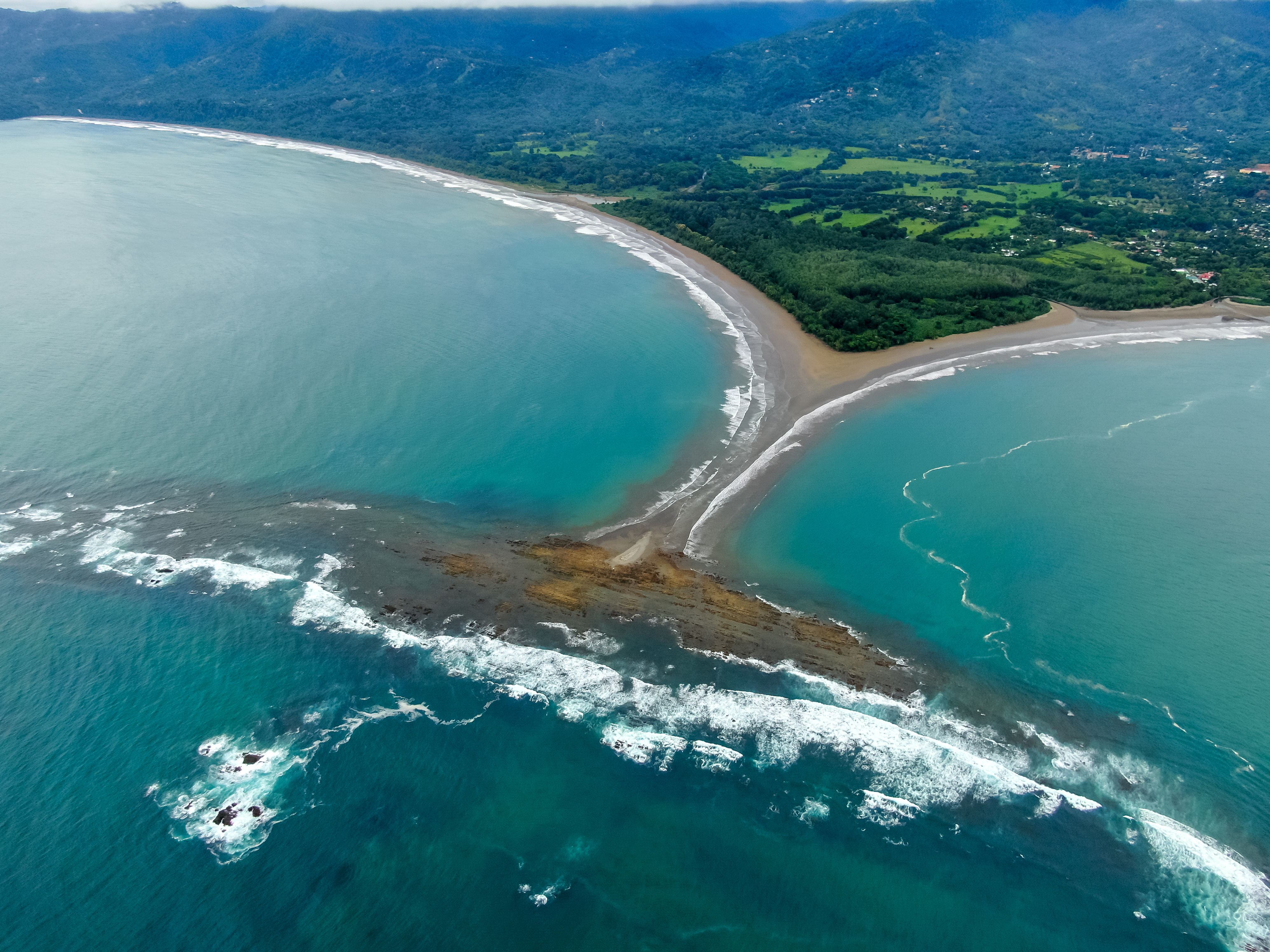
I vividly remember the two weeks I spent in Ojochal in February of 2018.
Maybe it was the 22-mile stretch of stunning beaches known as Costa Ballena, punctuated by the giant rock and sand formation that not only has the distinct shape of a whale’s tail, but is located in the exact spot where hundreds of humpback whales gather each year.
Or perhaps it was the multiple gourmet dining establishments nestled in the rainforest just across the road from Playa Tortuga, making it quite clear there was no traditional “downtown” to this town, but that didn’t mean there weren’t delights to be found behind lush groves of tropical trees.
But it’s probably that it was from this idyllic location that I negotiated with three different companies for the sale of our StudioPress division. Literally sitting next to the pool of the small estate we rented for a song, I set the stage for the largest transaction of my life to that point.
So, if you think Costa Rica is just for retirees, think again. Ojochal is an expat town filled with active “on-the-ground” entrepreneurs mixed in with the digitally independent variety.
In other words, the Central and Southern Pacific regions of Costa Rica easily challenge the “retiree-only” narrative, offering a productive work environment wrapped in natural splendor that doesn’t require waiting until your mid-60s (or later) to enjoy.
Where Rainforest Meets Ocean, Opportunity Meets Lifestyle
The Central Pacific Coast begins near the end of the Nicoya Peninsula and extends south to Dominical, while the South Pacific Coast (or “Southern Zone”) stretches from Dominical to the Panamanian border.
Unlike the drier Gold Coast region to the north, these areas feature lush rainforest that meets pristine beaches. This creates a dramatically different atmosphere that shapes everything from daily routine to business opportunities.
As Jason Holland notes in his comprehensive analysis for International Living:
Many expats say that the region still has a laidback lifestyle and vibrant nightlife reminiscent of the Florida Keys a couple of decades ago.
This comparison perfectly captures what makes this region so special. It’s a rare blend of established infrastructure with authentic character that hasn’t been sanitized by over-development.
The area’s transformation accelerated with the completion of the Caldera Highway, cutting travel time between coastal regions and the Central Valley to just over an hour. This connectivity matters tremendously when you head to San José’s international airport, high-quality medical facilities, and comprehensive shopping options — all without sacrificing the delights of beach living.
I’ve found few places that balance connectivity with tranquility as effectively as this region. The improved highway infrastructure means you can transition from video calls on your ocean-view terrace to in-person meetings in the capital city within the same day if necessary.
But before making moving plans, make sure to understand the complete picture.
The climate remains consistently warm and humid year-round, moderated by ocean breezes but potentially challenging for those accustomed to seasonal variation. This is one of the reasons why much of the expat population lives in the cooler Central Valley and goes to the beach when desired.
The region is also noticeably less upscale compared to the lush resorts of the Gold Coast, which may prompt concerns about crime. While I haven’t experienced anything like that, you should always use common sense at night and when property hunting by investigating safety and security variables, just as you would in any major U.S. city.
Finally, the ocean itself presents both opportunity and risk. Strong rip currents make swimming dangerous in certain areas — a crucial consideration if routine access to the ocean factors into your lifestyle plans.
Do your due diligence by consulting locals about weather patterns, location safety, and swimming spots before diving in. And then go beyond that initial investigation to spotting local business opportunities with the same mindset.
Now let’s take a look at the various towns that dot the Central and Southern coasts.
Choose Your Location, Choose Your Own Adventure
Up first, Jacó exemplifies the sweet spot many digital entrepreneurs may seek — infrastructure reliability with lifestyle advantages impossible to find in traditional business centers.
This lively beach town offers living options spanning from budget-conscious to luxury and includes high-rise condos, gated communities, and building lots. The 2.5-mile beach provides both relaxation and world-class surfing opportunities, with regular competitions attracting international participants.
The main thoroughfare, Avenida Pastor Díaz, features everything needed for balanced productivity: the Teatro Jacó entertainment center, Jacó Walk shopping complex, diverse international restaurants, banking services, and cafés.
For those evenings when you’ve closed your laptop and need celebration, the beachfront area transforms into an energetic social scene with restaurants, galleries, and nightlife options. Just a heads up, prostitution is legal in Costa Rica, and Jacó offers this entertainment option within a tightly-controlled area of town.
Ten minutes north, Playa Herradura presents a very different value proposition.
Once a quiet seaside village primarily attracting Costa Ricans and budget travelers, it now hosts the JW Marriott golf resort and Los Sueños marina. While real estate commands premium prices, business-owning expats who are successful enough to afford luxury will find the combination of world-class amenities and tranquility compelling.
Head to the south, and Manuel Antonio balances natural preservation with practical convenience.
Home to Costa Rica’s most popular national park (despite being one of its smallest at 4,000 acres), the area masterfully preserves its ecological treasures while developing surrounding infrastructure. The nearby port city of Quepos provides all the necessities with grocery stores, hardware outlets, and daily conveniences that reduce logistical friction for residents.
The world-class Marina Pez Vela in Quepos offers 195 slips plus comprehensive services, creating a sport fishing hub that attracts international visitors year-round. This tourism driver creates peripheral business opportunities spanning hospitality, tour operations, and specialty retail — perfect for those with an Untourist approach looking to expand beyond purely digital prospects.
If you’re looking to prioritize a quieter home base without sacrificing connectivity, Dominical marks the transition point between the Central and South Coasts.
This surfer-friendly village retains its laid-back character despite growing popularity. The real estate market reflects this evolution — once significantly less expensive than areas to the north, prices have surged, particularly in the mountainous Front Ridge area that offers panoramic ocean views.
What makes Dominical particularly appealing is its commitment to simplicity. Holland describes it perfectly:
It’s a simple, relaxed place, worlds away from the trendy tourist traps with overpriced restaurants, sprawling resorts, and obnoxious crowds.
This environment fosters the mental clarity essential for strategic thinking and creative problem-solving. This may be impossible to achieve amid constant interruption by carefree tourists.
Don’t Miss Uvita and Ojochal
Keep going further south, and you come to Uvita,which has emerged as the commercial center of Costa Ballena, the 22-mile coastal stretch that includes Dominical to the north and Ojochal to the south.
As mentioned (and seen) above, the region’s defining feature is a sandbar known as “The Whale’s Tail” that connects the mainland to a coral reef. To me, this symbolizes the area’s unique appeal as a combination of natural wonder and practical accessibility.
The experiences of transplants like Michelle and Fabiana, who relocated from Toronto in 2016, provide valuable insights for entrepreneurs considering similar moves.
After exploring multiple regions, they chose Uvita specifically for its “older, laidback vibe and the lush, green, jungle backdrop” while still offering “paved roads… plenty of stores and restaurants” without feeling overdeveloped. This balanced development stage — infrastructure without overcommercialization — creates the perfect environment for focused productivity.
Just south of Unvita and now we’re back in Ojochal. And the story of John and Janet Chantry illustrates another entrepreneurial trajectory of the Untourist variety.
Leaving behind professional careers in Toronto (he as a musician, she as a business owner), they purchased and transformed a small hotel into Alma de Ojochal, complete with The Bamboo Room restaurant and music venue.
Their transition embodies what many mid-career professionals seek: an opportunity to leverage accumulated skills and capital into ventures that blend business opportunity with lifestyle fulfillment. The Chantrys’ experience highlights another advantage: substantially lower operational costs.
Janet notes they often enjoy beach meals of casado — the national dish of fish, chicken, beef, or pork with rice, beans, and salad — for about $5 each, while even upscale dining rarely exceeds $50 for two, including wine and dessert. These economics create breathing room for businesses to develop without the crushing overhead common in major U.S. markets.
Healthcare accessibility represents another strategic advantage. As John explains:
Lots of people come here and stay with us and have complicated dental procedures done at local clinics. A guest recently told me he was quoted $3,900 for an implant in the U.S. that he paid $1,200 for in Costa Rica.
This cost differential extends across most medical services, significantly reducing one of the major expense categories for people over 50. It also frees you from the healthcare handcuffs that prevent people from starting businesses in the States.
The truth about location independence is that it requires more than reliable internet and a picturesque backdrop. Once you’re in for more than a two-week vacation, the necessities of real life become crucial.
The Central and South Pacific regions of Costa Rica offer the complete package: connectivity, affordability, reliable infrastructure, and quality healthcare wrapped in natural beauty.
